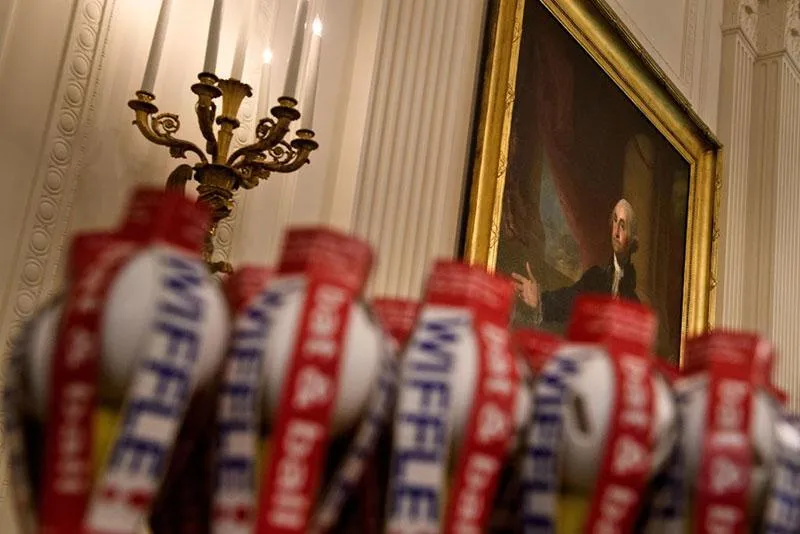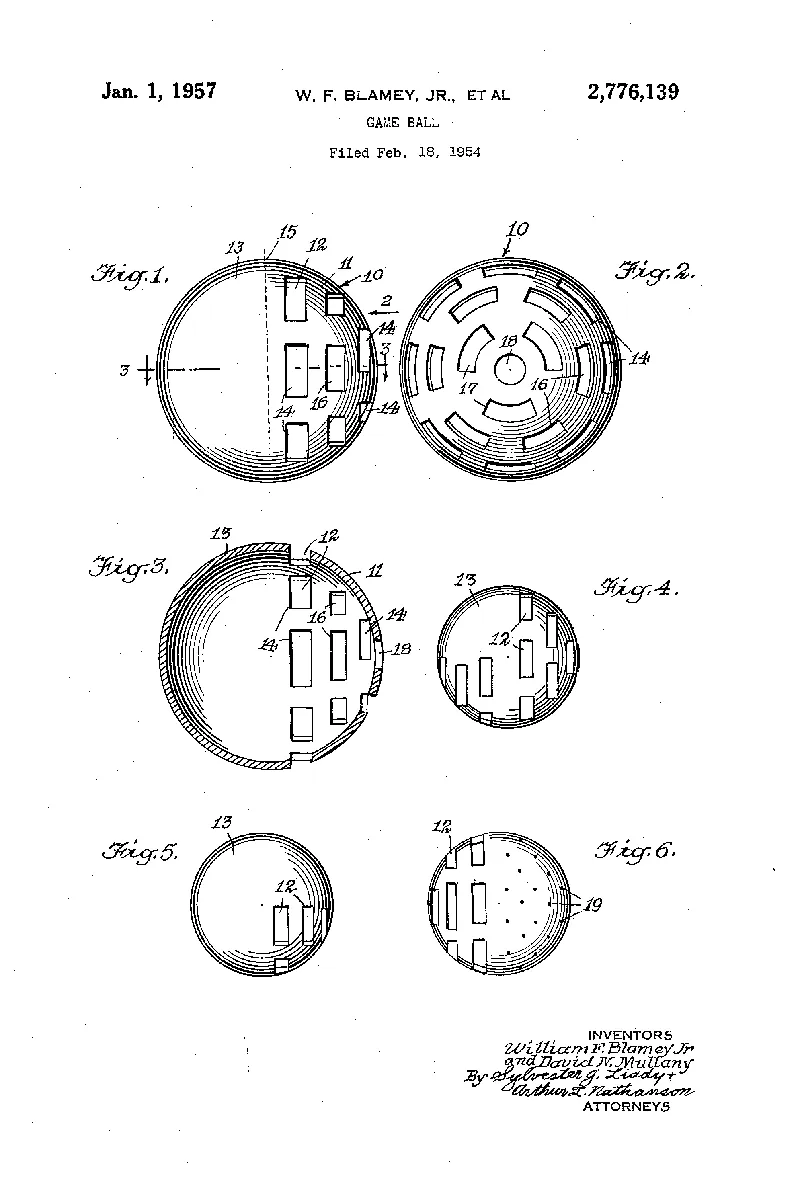How the Wiffle Ball Came to Be
Patented in 1957, the lightweight ball saved players’ arms and more than a few windows
/https://tf-cmsv2-smithsonianmag-media.s3.amazonaws.com/filer/7b/3c/7b3c6070-93c8-4d3b-8291-08fbea41ab08/wiffle_ball_box.jpg)
The score is tied 2-2 and the world championship game has gone into extra innings. There is a runner on third base and a dangerous hitter at the plate. On deck is the pitcher. No-brainer here: walk this guy and take your chances with the weaker hitter.
Big mistake. With the game on the line, the pitcher connects and drives it deep. Home run! Time to celebrate a world championship!
The 2019 World Wiffle Ball Championship (WWBC) in Midlothian, Illinois, that is. The Cult West Warriors of South Bend, Indiana, came up big against the Maple City Magic of La Porte, about 35 miles to the west, to win their fourth consecutive title.
“This was our first extra-inning championship game in the 40 years of our tournament,” says Mike Baniak, a WWBC commissioner. “We normally play six innings, but this one went eight with a dramatic home run to win it.”
No matter how many innings, Wiffle Ball has been a popular pastime for 66 years. The game follows the basic principles of baseball: throw the ball, hit the ball, catch the ball. It can be as close to the original as you want—or revised to meet the friendly confines of the smallest backyard or number of players on a team. To eliminate the need for base running and ball chasing, you can align the field in a “V” shape, then marking off areas for singles, doubles, triples and, of course, homers. Play with as few as two people or as many people as you can jam into the space. Like in baseball, three swings and you are out—unless there is a foul tip on the third strike. The batter also is called out on caught balls, either in the air or on the ground. If the ball gets by the fielder, then it is a hit and where it lands determines if it is a single or more. No running is involved, so imaginary runners advance as the hit parade continues.

This enduring and endearing game has captivated the passions of young and old alike—from backyard clashes with trees and rocks for bases to world championship series played in mini-stadiums designed to look like major-league parks.
At another championship series in Vermont, the Travis Roy Foundation Wiffle Ball Tournament, you’ll find reduced replicas of Fenway Park, Wrigley Field and even the “Field of Dreams” diamond, complete with corn growing on the edge of the outfield.
“We think our tournament is the oldest in the world,” Baniak says. “The WWBC started 40 years ago as a joke but it kept growing year after year. We have 60 teams from 12 different states. It’s a testament to the popularity of the game.”
Patented in 1957, the lightweight plastic Wiffle Ball comes with slots on one side to make it easier to throw curves and other pitches without putting undue stress on young arms. It was invented three years earlier by David Mullany, who got the idea after watching his namesake son playing a makeshift game of baseball with his brother and friends in the front yard of their home. Instead of a regulation ball and bat, they were using a plastic golf ball and broomstick in an attempt to keep from breaking windows or having to chase home runs down the street.
“My father complained his arm was hurting from trying to throw curves with that small ball,” says the third David Mullany, who is currently president of The Wiffle Ball, Inc. “My grandfather figured he could come up with something better for them to play with.”
As luck would have it, the senior Mullany, a businessman who was between jobs at the time, knew someone at Coty Perfume, which at the time packaged its product in a hard plastic container about the size of a baseball. He asked for samples and began whittling designs to see which worked best for pitching. After several rounds of trial and error, he hit upon a prototype with eight oblong cuts on one half of the ball, which made it easy for anyone to throw a curve or other spinning pitch.
The kids loved it and soon Mullany could see the potential for it growing beyond his own front yard. He designed it with William Blamey and applied for a patent in 1954, which was granted three years later under the simple title “Game Ball.” U.S. patent 2,776,139 describes the invention as being durable, lightweight and inexpensive to produce. Because of the holes, it also read, the ball “will vary in flight when thrown and when struck.”

Coming up with a name for the new invention took some thinking. Mullany’s grandfather decided to go with “whiff,” a slang term meaning to swing and miss. He came up with “whiffle” but then dropped the “H” when he applied for the trademark.
“It also meant he needed one less letter for the sign on the building,” Mullany chuckles.
Originally, the inventor sold Wiffle Balls from the trunk of his car. The plastic ball with holes in it quickly became popular and would sell out in a matter of days. The long and slender Wiffle Bat was added a few years later to complete the set.
Business boomed in 1959 when F.W. Woolworth placed a huge order for its national chain of stores. That’s when Mullany’s grandfather opened a factory in Shelton, Connecticut. Sixty years later, it is still the company’s headquarters, employing 15 full-time workers.
Making Wiffle Balls is a two-step process. First, the two halves – one solid, the other with holes – are created by an injection-molding machine. Then, these two pieces are inserted in a special machine that presses them together. It is an efficient process that enables the company to pump out product at a fast rate.
The Wiffle Ball, Inc. remains a family affair. The third David Mullany runs it with his brother Stephen. The second David Mullany, who inspired the invention when he was 12 years old, is semi-retired but still comes in to the factory a few hours each day. The thought of selling the business or going overseas for cheaper manufacturing has never been a consideration.
“This is where we live,” Mullany says. “We’re all within six or seven miles of the factory. Why would we want to go anywhere else?”
Mullany is proud that his grandfather’s invention was inducted into the National Toy Hall of Fame in 2017. He won’t say exactly how many Wiffle Balls have been produced by his company but does acknowledge that it is well in excess of 100 million. Demand is higher than ever as newer generations discover the fun of playing with the unique invention on sandlots, at ball fields or in their own backyards.
“What makes Wiffle Ball so appealing is its simplicity,” he says. “You only need two people to play and not a lot of space. And it’s intergenerational. It’s the kind of game where a young kid can compete against a seasoned player. The age difference may be different in other sports, but not Wiffle Ball.”
As for David and Stephen, they still play Wiffle Ball when they can. Every now and then, they will challenge each other to a game to determine the company champion.
“I’ll grab the ball and bat and say, ‘Let’s go!’” Mullany says. “Then we go outside and talk smack.”
/https://tf-cmsv2-smithsonianmag-media.s3.amazonaws.com/accounts/headshot/dave.png)


/https://tf-cmsv2-smithsonianmag-media.s3.amazonaws.com/accounts/headshot/dave.png)